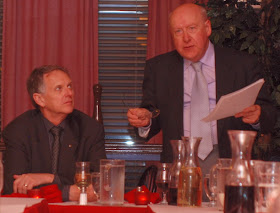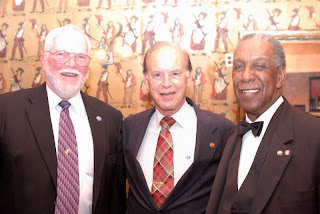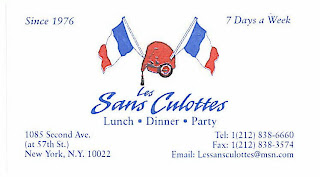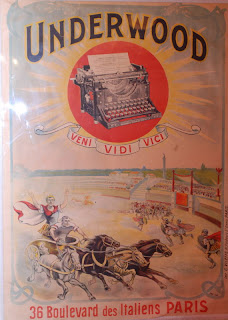 |
| Host Bill Thomas and guest speaker Trevor Stewart at Les Sans Culottes, New York City, October 6, 2008. |
So this Scotsman walks into a French restaurant and starts talking about a novella set in Italy.
No, this isn’t the set-up to a punchline. It is essentially what happened Monday night in New York City. It’s the details that count.
So there we were: Fifteen luminaries in the field of Masonic education (and me) gathered – or maybe “huddled” – inside the intimate upstairs dining room at Les Sans Culottes on Second Avenue to hear W. Bro. Trevor Stewart discourse on “St. Irvyne or the Rosicrucian” by Percy Bysshe Shelley, a work of short fiction in the Gothic genre written when the author was still a college student.
Our teacher, in the middle of a whirlwind speaking tour of the U.S., was none other than the very same Trevor Stewart of Quatuor Coronati fame; Past (2004) Prestonian Lecturer; Past Master of Inverness Lodge No. 6; the Deputy Master of Robert Moray Lodge of Research in Scotland; &c., &c.
His presentation is titled “Enlightenment in the Alps: Shelley’s Forgotten ‘Rosicrucian’ Novelette, ‘St. Irvyne’ ” Since this is what Trevor did for a living, no one was surprised by his dexterous delivery of biographical fact, plot summary (which actually was more compelling than the story itself) and esoteric context, which, naturally, is what brought us together that evening.
 “Shelley’s “St. Irvyne: or, The Rosicrucian” was one of his youthful excursions into literary creativity,” Trevor began. “It was written even while he was in his final year at Eton.” His ambition to author a three-part novel did not materialize, so what remained of the story was published in 1811 pseudonymously by “A Gentleman of the University of Oxford.” The young author may have hoped that the Oxford pedigree would have lended it credibility and boosted sales – not that he needed the money – as the market for Gothic tales was burgeoning at that time.
“Shelley’s “St. Irvyne: or, The Rosicrucian” was one of his youthful excursions into literary creativity,” Trevor began. “It was written even while he was in his final year at Eton.” His ambition to author a three-part novel did not materialize, so what remained of the story was published in 1811 pseudonymously by “A Gentleman of the University of Oxford.” The young author may have hoped that the Oxford pedigree would have lended it credibility and boosted sales – not that he needed the money – as the market for Gothic tales was burgeoning at that time.“The language of the opening paragraph gives readers some idea of the events to expect later,” Trevor explained, reading:
Red thunder-clouds, borne on the wings of the midnight whirlwind, floated, at fits and starts, athwart the crimson orbit of the moon; the rising fierceness of the blast sighed through the stunted shrubs, which, bending before its violence, inclined toward the rocks whereon they grew; over the blackened expanse of heaven, at intervals was spread the blue lightning’s flash; it played upon the granite heights and, with momentary brilliancy, disclosed the terrific scenery of the Alps, whose gigantic and misshapen summits, reddened by the transitory moon-beam, were crossed by the black fleeting fragments of the tempest-clouds … In this scene, then, at this horrible and tempestuous hour, stood Wolfstein.
 I have to confess a few things. When it comes to English literature, I am, always have been, and likely always will be, an Elizabethan guy, and not a Romantic. And I’ve always had a bias against Shelley in particular, mostly for the way he lived his life. (An atheist. Can you imagine?!) And as I began to read this novelette during the summer, I forgot to read it for pleasure, and instead tried to decode every sentence, looking for the keys to Rosicrucianism. And I thought I’d found a treasure in that opening paragraph. Actually just that first sentence. That’s the longest run-on sentence I’ve read in some time. This guy could have written Masonic ritual! Anyway, I had thought I’d found the Four Elements packed into that lengthy introduction, but Trevor reminded us that this style of writing is the hallmark of the Gothic genre.
I have to confess a few things. When it comes to English literature, I am, always have been, and likely always will be, an Elizabethan guy, and not a Romantic. And I’ve always had a bias against Shelley in particular, mostly for the way he lived his life. (An atheist. Can you imagine?!) And as I began to read this novelette during the summer, I forgot to read it for pleasure, and instead tried to decode every sentence, looking for the keys to Rosicrucianism. And I thought I’d found a treasure in that opening paragraph. Actually just that first sentence. That’s the longest run-on sentence I’ve read in some time. This guy could have written Masonic ritual! Anyway, I had thought I’d found the Four Elements packed into that lengthy introduction, but Trevor reminded us that this style of writing is the hallmark of the Gothic genre.But there is more to this opening scene that perhaps the initiated eye may see without reading too much into it. Trevor did not read this aloud, probably in the interest of time, but that ellipsis in the excerpt above represents, in part, this description of our hero Wolfstein: “without one existent earthly being whom he might claim as friend, without one resource to which he might fly as an asylum from the horrors of neglect and poverty.” Hey, we’ve all been there.
And it is at this time, with thoughts of death about to overwhelm him, when Wolfstein is spared a desperate suicide upon being discovered by a band of monks passing by. The monks in turn find themselves surrounded by number of mountain bandits who, for reasons not defined at that point, take in Wolfstein and welcome him, penniless, friendless and hopeless, as one of their own (after robbing and dispatching the monks).
The “banditti troop” retires to its cavern lair. “Over the walls of the lengthened passages putrefaction had spread a bluish clamminess.” Putrefaction!
Shortly the bandits assail other mountain travelers, taking captive the beautiful Megalena, a femme fatale who beguiles both bandit leader Cavigni and newcomer Wolfstein alike. Fearing losing Megalena to Cavigni, Wolfstein murders his leader with poison. The deed is witnessed by Ginotti, a mysterious and respected member of the bandit group.
For reasons not revealed at the time, Ginotti spares Wolfstein the retributive death duly earned, and abets his and Megalena’s escape. The couple flees to Genoa.
Ginotti follows the couple. An expert in disguise, he is able to appear suddenly and unexpectedly to Wolfstein’s repeated shock. Ginotti “manages to extort from the young man a promise that, at some future date, he will accept a solemn duty which he, Ginotti will place on him,” Trevor related. It is at this time when we realize Ginotti is our story’s eponymous Rosicrucian, a Magus in search of an apprentice: Wolfstein.
Ginotti: think alchemical sun (giorno/day) and moon (notte/night).
And here’s why it’s great to have your English literature professor double as a IX° Masonic Rosicrucian.
“The image of the Magus has spread far and has lasted long in most literatures and legends,” said Fratre Trevor, just getting warmed up. “There has scarcely been a people who have not cherished the idea that certain very select men, who after profound and prolonged study undertaken in self-imposed isolation, have become thereby custodians of secret wisdom and wielders of mysterious powers.”
“Interestingly, one of the best accounts, by Francis Barrett, titled simply ‘The Magus: or, The Celestial Intelligencer,’ appeared in 1801, merely nine years before Shelley began his novel,” he continued. “More recently, Professor Elizabeth Butler of Cambridge wrote the standard modern ‘expose’ titled ‘The Myth of the Magus’ (1948) in which she identifies 10 principle features of the Magus figure throughout the centuries.”
Those 10 are:
He usually has a mysterious origin he cannot disclose to anyone. (Certainly the case with Ginotti.)
His birth is marked by celestial portents. (I’m reminded of the Nazarene.)
His infancy is menaced by enemies who seek his death. (Ibid.)
He undergoes a kind of initiation into ancient mysteries. (Luke Skywalker.)
In pursuit of further knowledge, he travels far and wide.
Usually he’ll undergo a contest that tests his abilities.
He endures a trial and persecution at the hands of the ignorant and/or the authorities.
There would be a sacrificial farewell, involving a confession or repentance to others.
He meets a violent or mysterious death.
Ultimately, he experiences resurrection and/or ascension into heaven, achieving divine justification.
So, how did the young Shelley know all of this?
“He was an omnivorous reader and must have been acquainted with the Faust legend, especially with Goethe’s famous version,” Trevor said. “He may have been aware of the careers and writings of well-known British Magi, like Dr. John Dee, Robert Fludd, Simon Forman, Thomas Jones, Edward Kelly and Robert Turner.
 “From extensive European alchemical literature, he may have known about the many engravings of Magi at work in their ‘laboratories.’ We have only to recall the example of one of Jan Diricks von Campen’s plates in Heinrich Khunrath’s ‘Amphitheatrum Sapientiae Aeternae’ (1602) which shows a solitary sage kneeling in adoration and ecstasy before a tented sanctuary surrounded by all of the paraphernalia of an alchemical workshop.”
“From extensive European alchemical literature, he may have known about the many engravings of Magi at work in their ‘laboratories.’ We have only to recall the example of one of Jan Diricks von Campen’s plates in Heinrich Khunrath’s ‘Amphitheatrum Sapientiae Aeternae’ (1602) which shows a solitary sage kneeling in adoration and ecstasy before a tented sanctuary surrounded by all of the paraphernalia of an alchemical workshop.”More importantly, there were men in recent memory who had well documented international fame, “or as some would say, ‘infamy,’ in Masonic or quasi-Masonic circles,” Trevor explained. “There was Count Cagliostro, who traveled Europe and founded a mysterious type of initiatic rite called ‘Egyptian Masonry’ that enjoyed enormous but brief fashion, for such was the spirit of the age.
“His contemporary was the Count de St. Germain, who was a genuine nobleman, but equally eccentric. His reputation among the salons rested upon his ‘mesmeric’ powers, and his equally mysterious ability to appear simultaneously in at least three places, far distant from each other.” (A joke was inserted here about grand officers desiring that secret ability.)
“Both of these ‘charlatans’ claimed to enjoy youth that was renewed perpetually by the Elixir of Eternal Life. Both claimed to be able to dispense this to others at need. Both claimed enigmatically to have sources of unlimited wealth. They certainly did not seem to suffer from any shortage of funds. Both claimed to have undergone some form of initiation which had bestowed adeptship.
“And,” Trevor continued, “these trailblazing careers across Europe occurred at the same time as the various sects of ‘enlightened’ ones were making their presence felt in various other quarters.” Pasqually’s Elus Cohens in France, Weishaupt’s Illuminati in Bavaria, and others. “Indeed from the mid 18th century to the beginning of the 19th, the whole of Europe seemed alive with secret initiatory rites, all claiming to possess ‘the true light.’”
And last, but not least, is Dr. James Lind, FRS, who had great influence over his young “disciple” Percy Bysshe Shelley. “Lind was tall, thin, white-haired, and solitary, of serious demeanor, very knowledgeable about obscure sciences and the Far East,” Trevor said. “He was an ideal figure for a Magus for any inquisitive schoolboy such as Shelley” who in turn followed that model. “His hands were always stained with the chemicals that he used in his solitary experiments” at Eton. “There is the well known report of him being discovered alone, surrounded by a circle of flames on the bare wooden floor.”
“He explained that he had been trying to raise the Devil,” Trevor added, “but only managed to raise a very irate master armed with a cane!”
So it is within this historic context that we also see the rise of the Gothic novel.
Defined by our speaker as “hugely popular in the 1790s and early 1800s, especially in England,” it usually featured a medieval building, “a ruined abbey or castle, with labyrinth secret passages underground,” and a villain who “pledged himself to esoteric purposes known only to himself until the end of the tale,” and a persecuted innocent hero. “There were charnel houses, tombs, graveyards, and Nature itself usually conspired to produce effects of gloomy terror at midnight,” Trevor added. “For Shelley, the image of the Magus fitted neatly into this context.”
Simultaneous to all of this is the growing fame of the alchemist. “Until about the late 17th century, alchemy was comprised of two parts: a secret knowledge of the functioning of the universe, and actual work in the laboratory,” said Trevor. “The latter was a prolonged and arduous attempt at a physical transformation of matter that was a mirror image of the simultaneous transformation of the alchemist’s own psyche.” In time, the lab work was supplanted by the inner work of a “spiritual chemistry” that, for literary purposes, could be depicted as a tampering with nature or even a challenge to deity.
St. Irvyne is not a person, but a place, a ruined, cavernous structure of significance to several characters for different reasons where our story climaxes. Early in the plot, Ginotti saves Wolfstein from certain death for his poisoning of the bandit leader Cavigni; aiding in Wolfstein’s escape, Ginotti obligates Wolfstein to agree to a solemn, but unspoken oath. This obligation is made clear at the tale’s end.
“Wolfstein arrives at the darkened vaults of the ruined Abbey of St. Irvyne to meet Ginotti, as per their prior arrangement. Ginotti has disclosed to Wolfstein that he has acquired the secret of eternal life, along with other arcane powers,” Trevor explained. “He is anxious to pass this wisdom to a specially chosen disciple – Wolfstein – so he can die in peace.”
But Wolfstein, at this moment of truth, balks. He will not go along with Ginotti, because doing so would defy nature and deity. “Suddenly, a Devil appears from Hell and drags Ginotti screaming into the eternal fires of his justified damnation,” as Trevor puts it. “Wolfstein, terrified at what he just witnessed in the blackness of the vault, drops dead!”
If you have progressed beyond the Sublime Degree, you know the value of a good vault.
“St. Irvyne” ends quite abruptly.
“Deeper grew the gloom of the cavern. Darkness almost visible seemed to press around them; yet did the scintillations which flashed from Ginotti’s burning gaze, dance on its bosom. Suddenly a flash of lightning hissed through the lengthened vaults. A burst of frightful thunder seemed to convulse the universal fabric of nature; and borne on the pinions of hell’s sulphurous whirlwind, he himself, the frightful prince of terror, stood before them. ‘Yes,’ howled a voice superior to the bursting thunder-peal, ‘yes, thou shalt have eternal life, Ginotti.’ On a sudden Ginotti’s frame mouldered to a gigantic skeleton, yet two pale and ghastly flames glared in his eyeless sockets. Blackened in terrible convulsions, Wolfstein expired. Over him had the power of hell no influence. Yes, endless existence is thine, Ginotti – a dateless and hopeless eternity of horror.”
Shelley concludes with an admonishment: “Let then the memory of these victims to hell and malice live in the remembrance of those who can pity the wanderings of error. Let remorse and repentance expiate the offences which arise from the delusion of the passions, and let endless life be sought from Him who alone can give an eternity of happiness.”
“This connects to Bob Davis’ thoughts on the handing on from father to son of that which we have acquired,” Trevor continued, referring to Bro. Bob’s writings on the importance of responsible men, especially Freemasons, initiating the young into lives of right thinking and right acting. “The tragedy here is the wisdom is lost.”
▲▼ ▲▼ ▲▼ ▲▼ ▲▼ ▲▼ ▲▼ ▲▼ ▲▼ ▲▼ ▲▼ ▲▼ ▲▼ ▲▼
The air upstairs at Les Sans Culottes was nearly as alive with electricity as the lightning-sparked skies over St. Irvyne itself. A question and answer period ensued, with great minds like John Mauk Hilliard and Ted Harrison and others trading their impressions of this novelette in the context of Masonic ritual and symbol. For the sake of privacy, I feel enjoined not to write of that.
 |
| From left: John Mauk Hilliard, Ted Harrison and Fred Waldron. |
 |
| The Brothers Harrison. From left: Robert, Ted and George. |
However I cannot close without praising our host, Bro. Bill Thomas of Shakespeare Lodge No. 750, who arranged all of this. Motivated by a desire to enjoy a relaxed evening of great discussion and dining, Bill brought us all together in this charming – in a friendly staff and unpretentious décor kind of way – eatery. He will be elected WM of American Lodge of Research on Oct. 29 at Grand Lodge’s building on 23rd Street.
 |
A toast!
|
Likewise, the restaurant itself cannot be ignored.

 The appetizers were really unlike anything I’ve experienced before. Abundant baskets of raw veggies and fruits, crocks of pâté, piles of fresh bread… all of it was eclipsed by the… well, I suppose I’ll call them “sausage trees!” If you use a banana rack at home, then just picture that device, but laden with an impressive variety of cured and smoked sausages and salamis. Specifically, two garlic sausages, one thick and one thin; one paprika salami; and other delicacies. I don’t know who their purveyor is, but I’ve never tasted meats like this. Similarly the pâté was terrific. If you’re a vegetarian or suffer from gout, this ain’t the place for you.
The appetizers were really unlike anything I’ve experienced before. Abundant baskets of raw veggies and fruits, crocks of pâté, piles of fresh bread… all of it was eclipsed by the… well, I suppose I’ll call them “sausage trees!” If you use a banana rack at home, then just picture that device, but laden with an impressive variety of cured and smoked sausages and salamis. Specifically, two garlic sausages, one thick and one thin; one paprika salami; and other delicacies. I don’t know who their purveyor is, but I’ve never tasted meats like this. Similarly the pâté was terrific. If you’re a vegetarian or suffer from gout, this ain’t the place for you.The entrees varied from salmon (with fish knife actually provided) to beef bourguignon, to roasted duck, to two chicken dishes: cordon bleu and tarragon. Dessert was a choice of either flan or the most decadent chocolate mousse… I can’t even describe it other than to say New York’s nanny-mayor would try to ban it if he knew it existed. Near the corner of Second Avenue and 57th, it is pretty much outside of my usual city orbit, but I’ll be back.
Bill, thanks for a terrific evening. And happy birthday Trevor!
No comments:
Post a Comment